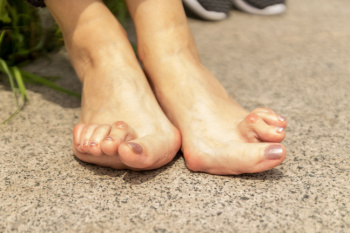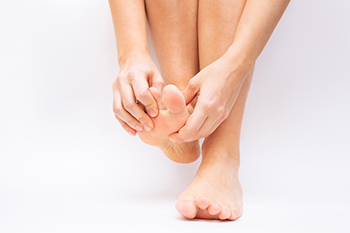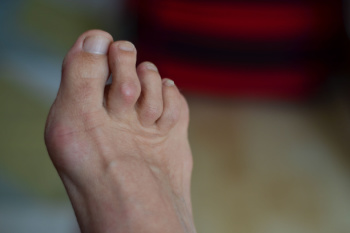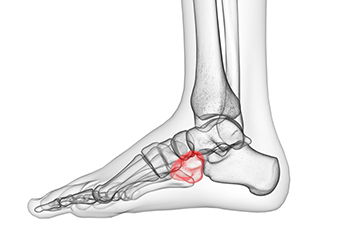Items filtered by date: August 2025
Rheumatoid Arthritis in the Feet

Rheumatoid arthritis, or RA, in the feet is an autoimmune condition where the immune system attacks joint tissues, causing inflammation, pain, and stiffness. Symptoms include swelling, tenderness, joint deformities, and difficulty walking. Causes are linked to immune system dysfunction, while risk factors include genetics and smoking. Over time, RA can damage cartilage and bone, leading to loss of mobility and chronic discomfort. A podiatrist can help by managing symptoms with custom orthotics, supportive footwear, and joint protection strategies. They can also provide advice on exercises to maintain flexibility. If foot pain or stiffness from RA is affecting daily life, it is suggested that you speak with a podiatrist who can guide you toward effective relief and management tips.
Because RA affects more than just your joints, including the joints in your feet and ankles, it is important to seek early diagnosis from your podiatrist if you feel like the pain in your feet might be caused by RA. For more information, contact Dr. Paul Drucker of NYC Foot Care, PC. Our doctor will assist you with all of your podiatric concerns.
What Is Rheumatoid Arthritis?
Rheumatoid Arthritis (RA) is an autoimmune disorder in which the body’s own immune system attacks the membranes surrounding the joints. Inflammation of the lining and eventually the destruction of the joint’s cartilage and bone occur, causing severe pain and immobility.
Rheumatoid Arthritis of the Feet
Although RA usually attacks multiple bones and joints throughout the entire body, almost 90 percent of cases result in pain in the foot or ankle area.
Symptoms
- Swelling and pain in the feet
- Stiffness in the feet
- Pain on the ball or sole of feet
- Joint shift and deformation
Diagnosis
Quick diagnosis of RA in the feet is important so that the podiatrist can treat the area effectively. Your doctor will ask you about your medical history, occupation, and lifestyle to determine the origin of the condition. Rheumatoid Factor tests help to determine if someone is affected by the disease.
If you have any questions, please feel free to contact our offices located in 70th Street Manhattan, 60th Street Manhattan, Jamaica, Queens, Plainview, NY and Fair Lawn, NJ . We offer the newest diagnostic and treatment technologies for all your foot care needs.
Common Causes of Big Toe Pain

Sharp pain in the big toe can interfere with daily movement and may signal underlying conditions. Gout causes sudden, intense pain due to uric acid buildup in the joint. Sesamoiditis results from inflammation of the small bones under the toe. Turf toe is a sprain from forceful bending, often seen in athletes. Additionally, lumps such as cysts or bone growths can also cause discomfort and pressure. A podiatrist can perform a detailed evaluation, provide imaging if needed, and offer targeted treatments to reduce pain and restore function. If you are suffering from big toe pain, it is suggested that you schedule a visit with a podiatrist to identify the cause and begin the path to healing and relief.
Toe pain can disrupt your daily activities. If you have any concerns, contact Dr. Paul Drucker of NYC Foot Care, PC. Our doctor can provide the care you need to keep you pain-free and on your feet.
What Causes Toe Pain?
Most severe toe pain is caused due to a sports injury, trauma from dropping something heavy on the toe, or bumping into something rigid. Other problems can develop over time for various reasons.
Toe pain can be caused by one or more ailments. The most common include:
- Trauma
- Sports injury
- Wearing shoes that are too tight
- Arthritis
- Gout
- Corns and calluses
- Hammertoe
- Bunions
- Blisters
- Ingrown toenails
- Sprains
- Fractures (broken bones)
- Dislocations
When to See a Podiatrist
- Severe pain
- Persistent pain that lasts more than a week
- Signs of infection
- Continued swelling
- Pain that prevents walking
Diagnosis
In many cases the cause of toe pain is obvious, but in others, a podiatrist may want to use more advanced methods to determine the problem. These can range from simple visual inspections and sensation tests to X-rays and MRI scans. Prior medical history, family medical history, and any recent physical traumatic events will all be taken into consideration for a proper diagnosis.
Treatment
Treatments for toe pain and injuries vary and may include shoe inserts, padding, taping, medicines, injections, and in some cases, surgery. If you believe that you have broken a toe, please see a podiatrist as soon as possible.
If you have any questions please contact our offices located in 70th Street Manhattan, 60th Street Manhattan, Jamaica, Queens, Plainview, NY and Fair Lawn, NJ . We offer the newest diagnostic and treatment technologies for all your foot and ankle needs.
What Causes Hammertoe?

Hammertoe occurs when one of the small toes becomes bent at the middle joint, causing it to point downward instead of lying flat. This deformity often begins as a mild imbalance and becomes more rigid over time. It can be painful and make wearing shoes difficult. The most common cause is an imbalance in the muscles and tendons that support the toe. Wearing tight or narrow shoes, especially those with high heels, can force the toes into an unnatural position. Over time, this leads to the joint stiffening in that shape. Other causes include foot structure inherited from family, past injuries, and certain conditions such as arthritis or nerve damage. Early recognition is important to prevent the deformity from worsening. If you notice changes in the shape of a toe or experience pain or corns, an evaluation by a podiatrist is suggested.
Hammertoes can be a painful condition to live with. For more information, contact Dr. Paul Drucker of NYC Foot Care, PC. Our doctor will answer any of your foot- and ankle-related questions.
Hammertoe
Hammertoe is a foot deformity that occurs due to an imbalance in the muscles, tendons, or ligaments that normally hold the toe straight. It can be caused by the type of shoes you wear, your foot structure, trauma, and certain disease processes.
Symptoms
- Painful and/or difficult toe movement
- Swelling
- Joint stiffness
- Calluses/Corns
- Physical deformity
Risk Factors
- Age – The risk of hammertoe increases with age
- Sex – Women are more likely to have hammertoe compared to men
- Toe Length – You are more likely to develop hammertoe if your second toe is longer than your big toe
- Certain Diseases – Arthritis and diabetes may make you more likely to develop hammertoe
Treatment
If you have hammertoe, you should change into a more comfortable shoe that provides enough room for your toes. Exercises such as picking up marbles may strengthen and stretch your toe muscles. Nevertheless, it is important to seek assistance from a podiatrist in order to determine the severity of your hammertoe and see which treatment option will work best for you.
If you have any questions, please feel free to contact our offices located in 70th Street Manhattan, 60th Street Manhattan, Jamaica, Queens, Plainview, NY and Fair Lawn, NJ . We offer the newest diagnostic and treatment technologies for all your foot care needs.
Lateral Foot Pain and Cuboid Syndrome

Lateral foot pain refers to discomfort along the outer edge of the foot and may result from overuse, injury, poor foot mechanics, or conditions such as cuboid syndrome. This condition occurs when the cuboid bone is partially dislocated or misaligned, leading to sharp pain, weakness, or instability, especially during weight-bearing activities. Risk factors include ankle sprains, improper footwear, and repetitive stress. A podiatrist can diagnose the exact cause of lateral foot pain, perform necessary adjustments, provide custom orthotics, and recommend stretching and strengthening exercises. If you have persistent outer foot pain, do not ignore the symptoms. It is suggested that you promptly consult a podiatrist who can accurately diagnose and treat cuboid syndrome.
Cuboid syndrome, also known as cuboid subluxation, occurs when the joints and ligaments near the cuboid bone in the foot become torn. If you have cuboid syndrome, consult with Dr. Paul Drucker from NYC Foot Care, PC. Our doctor will assess your condition and provide you with quality foot and ankle treatment.
Cuboid syndrome is a common cause of lateral foot pain, which is pain on the outside of the foot. The condition may happen suddenly due to an ankle sprain, or it may develop slowly overtime from repetitive tension through the bone and surrounding structures.
Causes
The most common causes of cuboid syndrome include:
- Injury – The most common cause of this ailment is an ankle sprain.
- Repetitive Strain – Tension placed through the peroneus longus muscle from repetitive activities such as jumping and running may cause excessive traction on the bone causing it to sublux.
- Altered Foot Biomechanics – Most people suffering from cuboid subluxation have flat feet.
Symptoms
A common symptom of cuboid syndrome is pain along the outside of the foot which can be felt in the ankle and toes. This pain may create walking difficulties and may cause those with the condition to walk with a limp.
Diagnosis
Diagnosis of cuboid syndrome is often difficult, and it is often misdiagnosed. X-rays, MRIs and CT scans often fail to properly show the cuboid subluxation. Although there isn’t a specific test used to diagnose cuboid syndrome, your podiatrist will usually check if pain is felt while pressing firmly on the cuboid bone of your foot.
Treatment
Just as the range of causes varies widely, so do treatments. Some more common treatments are ice therapy, rest, exercise, taping, and orthotics.
If you have any questions, please feel free to contact our offices located in 70th Street Manhattan, 60th Street Manhattan, Jamaica, Queens, Plainview, NY and Fair Lawn, NJ . We offer the newest diagnostic and treatment technologies for all your foot care needs.

